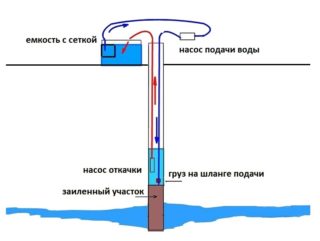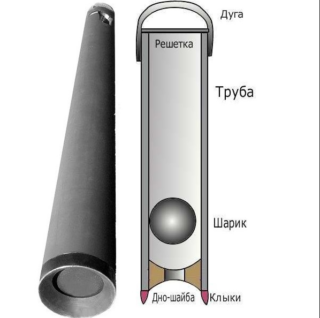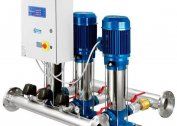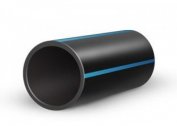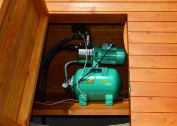Autonomous water intake facilities in a country house or in a country house eventually become silted and clogged with sand, which leads to a decrease in water supply efficiency and a deterioration in water quality. An economical solution to the problem is to clean the well from contamination on its own. But it is important to find out the causes of siltation and sanding, eliminating which can significantly increase the interval between procedures.
The main causes of clogging
Most often, prerequisites are laid at the stage of construction. For example, pollution can occur due to an unpressurized cap, a caisson.
Other causes of clogging include:
- improperly selected filter - grains of sand and fragments of organics seep through large cells;
- insufficient pumping of water - there is a constant subsidence of silt and clay particles to the bottom;
- the use of rotary type pumps at great depths - if the indicator is more than 10 m, they can not cope;
- lack of protection against getting debris from the surface into the mine;
- untimely maintenance of pressure equipment and cleaning of filter elements;
- change in direction of subsoil sources.
And if the last problem can be dealt with only by drilling a well in a new place, all the rest can be solved by reconstruction of the units of the water intake installation, replacement of the filter or pump, timely pumping.
If the owner of the site does not have the ability to systematically pump out water during the year, you need to do this more intensively in the summer. An increase in the number of procedures reduces the need for mine cleaning.
Self-cleaning methods for silt and sand
There are many ways to clean a well installation with your own hands, but any of them refers to three technologies: flushing, pumping or purging.
Pumping down
Do-it-yourself cleaning of a well using a vibration pump is one of the simplest methods. Lower the pressure device to the bottom and start it. All particles of debris accumulating at the bottom of the shaft will rise and will be brought out.
The process is not fast, since the pump unit housing is very hot from long work, and the device must be stopped from time to time. It is also necessary to periodically conduct clean water through the system.
The use of vibration pumps is possible only in intakes from a depth of 10 meters. You can clean the well with an ordinary pump, if the water layer lies no deeper than 40 meters.
Pressure equipment flushing
There is another method using pressure equipment, but it is technologically flushing. Two pumps are required here. Do-it-yourself washing of the well from sand is carried out according to this technology:
- The deep pressure unit with the lower water intake is lowered to the bottom. It is needed for pumping fluid.
- The second pump is used to supply a water stream, shaking deposits. The liquid can be supplied either from a pre-filled container or from another water supply source.
- With a constant supply of fresh water, the borehole structure is washed out - all suspensions, even fixed on the walls of the mine, are separated and brought out.
The hose used for drainage must be shaken systematically to avoid damage to the pump.
Application
Self-cleaning of the intake structures can be performed using a bailer.This technique is used if the pollution is not too strong, and the shaft depth is up to 25 meters.
A choke is a pipe section on a cable with a net and a ball inside.
The pumping itself is performed in this way:
- The device is sent to the bottom, and then raised to a height of 50–70 cm and sharply thrown.
- Water enters the inner part of the pipe under pressure, and the ball goes first up and then down and closes the hole.
- Such actions are performed several times.
- Then the device is pulled out of the mine and cleaned of dirt.
Approximately 0.5 kg of sand and silt can be fished out in one approach. Performing cleaning by this method, determine the rate of clogging of the well.
You can create this simple device yourself or buy it at a hardware store. It should be noted that one person will not be able to cope with work. A winch and a minimum of two adult men will be required.
Water purge purge
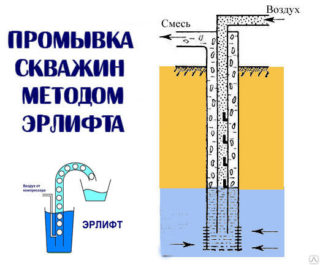 A method that allows you to clean the well of sand and silt on your own, is based on the laws of Archimedes. A well shaft is a reservoir of water. It will be necessary to lower the pipe into it, from the lower part of which air under high pressure escapes through the compressor. As a result, an air-foamy mixture is formed in the mine. Together with the water flow, all the accumulated debris in it rises.
A method that allows you to clean the well of sand and silt on your own, is based on the laws of Archimedes. A well shaft is a reservoir of water. It will be necessary to lower the pipe into it, from the lower part of which air under high pressure escapes through the compressor. As a result, an air-foamy mixture is formed in the mine. Together with the water flow, all the accumulated debris in it rises.
The compressor cleaning process requires constant monitoring. The purge is stopped at the moment when the exit of water has stopped.
If the well is deep, it is better to use airlift for purging - a specialized pneumatic elevator that uses compressed air or technical gas.
Chemical method of purification
If the previous methods practically did not increase the flow rate of the well, then the filters are covered with hardened ferruginous and calcareous suspensions. If it is impossible to replace them, it is worth resorting to extreme measures - acid cleaning. This option involves pouring the battery acid used for vehicles at the bottom of a well emptied by a pump.
The outlet is closed tightly with a plug and the water intake structure is left for a couple of days. After that, water is pumped out several times. Even after these procedures, it is not suitable for drinking and cooking for a month. Liquid is taken only for technical needs.
The more pumping is done, the sooner the leaching of acids from the well will occur. But before consuming water, it should be tested in laboratory conditions to confirm safety.
Selection Criteria
When choosing a cleaning method, be sure to consider:
- depth of the intake shaft;
- the availability of suitable equipment;
- the number of people who will be able to participate in the cleansing process.
Well cleaning can be done much faster if there is no filter element. This allows you to lower the equipment to perform work to the bottom.
Preventative measures
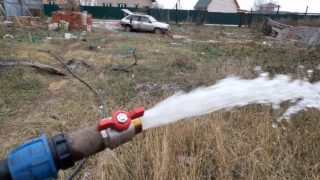
It is almost impossible to prevent siltation or sand clogging of the mine shaft, since subsoil sources always bring organic and inorganic fragments with them. But measures to reduce pollution are necessary.
First of all, secure the well from debris entering it from the outside. To do this, you will need to close the mine exit, for example, with sheet metal, plastic and wooden covers. Such coatings are easy to make on their own, but you can find the right items on sale.
It is possible to extend the operational life of a well by following a few simple rules of use:
- Drill in accordance with the technological rules, and upon completion, immediately flush the shaft until the fluid is completely cleaned.
- Check if the casing is leaking or if the filter element is damaged.
- Clean the filter unit regularly, and if worn, replace it.
- Protect the source from surface water and contaminants by means of a caisson, cap. You can seal the top of the casing, but this is a temporary solution.
- Select the appropriate pressure equipment based on the flow rate of the source. It is not recommended to use a vibration pump for pumping. In the process of vibration, mini-landslides of sand and organic compounds always occur. This technique is best used for cleaning.
A well cannot be left without water intake. The ideal operating mode is the daily intake of several tens or hundreds of liters of liquid. It can be provided with permanent residence in the house. If this fails for some reason, you will need to systematically, at least once every two months, take at least 100 liters of fluid.
Even correctly carried out preventive measures are not a 100% guarantee that it will be possible to avoid pollution of the water intake source. They only contribute to increasing the intervals between cleaning. An equipped well is cleaned twice a year, and an undeveloped well is cleaned several times a season.

